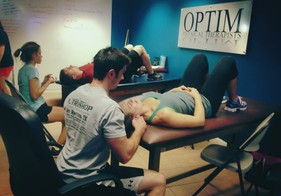- Home
- About Us
- TSPT Academy
- Online Courses
-
Resources
- Newsletter
- Business Minded Sports Physio Podcast
- Day in the Life of a Sports PT
- Residency Corner
-
Special Tests
>
-
Cervical Spine
>
- Alar Ligament Test
- Bakody's Sign
- Cervical Distraction Test
- Cervical Rotation Lateral Flexion Test
- Craniocervical Flexion Test (CCFT)
- Deep Neck Flexor Endurance Test
- Posterior-Anterior Segmental Mobility
- Segmental Mobility
- Sharp-Purser Test
- Spurling's Maneuver
- Transverse Ligament Test
- ULNT - Median
- ULNT - Radial
- ULNT - Ulnar
- Vertebral Artery Test
- Thoracic Spine >
-
Lumbar Spine/Sacroiliac Joint
>
- Active Sit-Up Test
- Alternate Gillet Test
- Crossed Straight Leg Raise Test
- Extensor Endurance Test
- FABER Test
- Fortin's Sign
- Gaenslen Test
- Gillet Test
- Gower's Sign
- Lumbar Quadrant Test
- POSH Test
- Posteroanterior Mobility
- Prone Knee Bend Test
- Prone Instability Test
- Resisted Abduction Test
- Sacral Clearing Test
- Seated Forward Flexion Test
- SIJ Compression/Distraction Test
- Slump Test
- Sphinx Test
- Spine Rotators & Multifidus Test
- Squish Test
- Standing Forward Flexion Test
- Straight Leg Raise Test
- Supine to Long Sit Test
-
Shoulder
>
- Active Compression Test
- Anterior Apprehension
- Biceps Load Test II
- Drop Arm Sign
- External Rotation Lag Sign
- Hawkins-Kennedy Impingement Sign
- Horizontal Adduction Test
- Internal Rotation Lag Sign
- Jobe Test
- Ludington's Test
- Neer Test
- Painful Arc Sign
- Pronated Load Test
- Resisted Supination External Rotation Test
- Speed's Test
- Posterior Apprehension
- Sulcus Sign
- Thoracic Outlet Tests >
- Yergason's Test
- Elbow >
- Wrist/Hand >
- Hip >
- Knee >
- Foot/Ankle >
-
Cervical Spine
>
- I want Financial Freedom
- I want Professional Growth
- I want Clinical Mastery
|
Are you currently performing spinal thrust manipulation in the clinic? If you answered no, why not? We asked this question at our first OPTIM COMT program two weekends ago. Aside from a lack of experience performing the techniques, a main reason physical therapy clinicians are not manipulating is because of potential complications associated with manipulation. In this post, I will analyze the true risk associated with spinal manipulation and how safe these techniques truly are with appropriate screening.  Cervical Manipulation Risks Cervical thrust joint manipulation is often viewed as a danger zone by physical therapists. For whatever reason, physical therapy schools avoid teaching cervical manipulations. In school the negative complications are ingrained in our minds. The greatest risk associated with cervical manipulation is inducing vertebral basilar insufficiency (VBI). VBI is defined as an occlusion or injury to the vertebral artery causing a decrease in bloodflow to the brain stem and posterior cranium. If the vertebral artery is affected, stroke or death could result. In addition to VBI, other adverse reactions can include neck soreness, radiating arm pain, nystagmus, headaches, ringing in the ears, and other less severe complications. Risk by the Numbers: What the Research Reports The exact risk of severe complications (VBI or death) is unknown. Rivett and Milburn estimate that 1 in 50,000 to 1 in 5,000,000 manipulations will result in neurovascular compromise (1). DiFabio et al performed an extensive literature review of 177 patients who experienced severe adverse events following cervical manipulation. Of the 177 patients, arterial dissection (VBI) was the primary diagnoses found. Additionally, DiFabio pointed out that only 2% of the severe injuries were performed by physical therapists (2). Others have reported the risk of VBI following cervical manipulation to be as high as 6 in 10,000,000 (3).
Conclusion The research suggests that severe adverse responses to spinal manipulation are extremely low. As physical therapists, we receive extensive training to assess for VBI and cauda equina syndrome. With a thorough subjective history and objective examination, you should be able to determine if the patient is appropriate for manipulation. If you find that the patient is demonstrating signs and symptoms of cauda equina or VBI, refer back to the appropriate medical provider. Stronger evidence on the benefits of spinal manipulation is emerging every year. If the patient is appropriate, we should be performing these techniques. If you do not feel prepared to perform these techniques, find a good manual therapy program to learn them! Let me know if you have any questions, Jim References:
1. Rivett, D.A., Sharples, K.J., & Millburn, P.D. (1999). Effect of pre-manipulative tests on vertebral artery and internal carotid artery blood flow: A pilot study. Journal of Manipulative and Physiological Therapeutics, 22, 368-375 2. Di Fabio, Richard P. "Manipulation of the Cervical Spine: Risks and Benefits."Physical Therapy 79.1 (1999): 50-65. 3. Coulter ID. Efficacy and risks of chiropractic manipulation: what does the evidence suggest? Integ Med1998;1: 61-6 4. J. D. Childs, T. W. Flynn, and J. M. Fritz, “A perspective for considering the risks and benefits of spinal manipulation in patients with low back pain,” Manual Therapy, vol. 11, no. 4, pp. 316–320, 2006.
0 Comments
Leave a Reply. |
Dr. Brian Schwabe's NEW Book in partner with PaleoHacks!
Learn residency-level content on our
Insider Access pages We value quality PT education & CEU's. Click the MedBridge logo below for TSPT savings!Archives
July 2019
Categories
All
|






 RSS Feed
RSS Feed